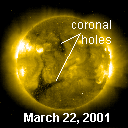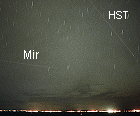|   SPACE WEATHER SPACE WEATHER
Current
Conditions
Solar Wind
velocity: 378.9 km/s
density:5.9 protons/cm3
explanation | more data
Updated: Today at 2202 UT
X-ray Solar Flares
6-hr max: C5 1650 UT Mar22
24-hr: M1 0820 UT Mar22
explanation | more data
Updated: Today at 2245 UT
Daily Sun: 22 Mar '01 
Sunspot group 9373, which is disappearing over the Sun's western limb, is still the most active sunspot on the solar disk. It has a beta-gamma magnetic field that may harbor energy for M-class eruptions.
Sunspot Number: 136
More about sunspots
Updated: 21 Mar 2001
Radio Meteor Rate
24 hr max: 29 per hr
Listen to the Meteor Radar!
Updated: 22 Mar 2001 Interplanetary Mag. Field
Btotal: 7.3 nT
Bz: 4.1 nT north
explanation | more data
Updated: Today at 2203 UT Coronal Holes:

The two coronal holes indicated in this extreme ultraviolet image could send solar wind streams toward Earth when they cross the Sun's central meridian in the days ahead. Image credit: SOHO Extreme UV Telescope.
More about coronal holes
 SPACE WEATHER SPACE WEATHER
NOAA
Forecasts
Solar Flares: Probabilities for a medium-sized (M-class) or a major (X-class) solar flare during the next 24/48 hours are tabulated below.
Updated at 2001 Mar 22 2200 UT
| FLARE | 24 hr | 48 hr | | CLASS M | 60 % | 60 % | | CLASS X | 01 % | 01 % |
Geomagnetic Storms: Probabilities for significant disturbances in Earth's magnetic field are given for three activity levels: active, minor storm, severe storm
Updated at 2001 Mar 22 2200 UT Mid-latitudes | 24 hr | 48 hr | | ACTIVE | 25 % | 20 % | | MINOR | 05 % | 05 % | | SEVERE | 01 % | 01 % |
High latitudes | 24 hr | 48 hr | | ACTIVE | 30 % | 30 % | | MINOR | 10 % | 10 % | | SEVERE | 05 % | 05 % |
| What's Up in Space -- 22 Mar 2001
Subscribe to Space Weather News! IMPACT! A weak interplanetary shock wave --the leading edge of a coronal mass ejection (CME) that left the Sun on March 19th-- buffeted Earth's magnetosphere this morning at ~1300 UT, but it did not trigger substantial geomagnetic activity.  Another coronal mass ejection might be following close behind the one that struck today. It left the Sun on March 20th when a solar flare exploded above sunspot group 9373 (near the Sun's western limb). The lopsided CME did not head directly for Earth, but it could nevertheless deliver a glancing blow to our planet's magnetosphere later today or tomorrow.  FAREWELL TO MIR: On March 22, 2001, the Russian Space Agency reports that space station Mir was 216.8 km above Earth and losing altitude at a rate of 3.4 km per day. Deorbiting maneuvers are underway. See also the Science@NASA story: "The End is Mir". FAREWELL TO MIR: On March 22, 2001, the Russian Space Agency reports that space station Mir was 216.8 km above Earth and losing altitude at a rate of 3.4 km per day. Deorbiting maneuvers are underway. See also the Science@NASA story: "The End is Mir".
Above: Photographer Paulo Raymundo captured one last glimpse of Mir on March 19th as it raced over Salvador, Brazil. Mir is not burning up in this image -- it's visible because of reflected sunlight. The 5-minute exposure also caught NASA's Hubble Space Telescope streaking among the stars!  NORTHERN LIGHTS: On Monday a coronal mass ejection hit Earth's magnetosphere and sparked a strong geomagnetic storm that lasted for nearly 36 hours. At its peak, the G3-category disturbance spawned auroras in the USA as far south as New York, Wisconsin and Washington State. Jan Curtis captured this photo of Northern Lights over Fairbanks, Alaska. For more images from around the world, please visit our AURORA GALLERY. NORTHERN LIGHTS: On Monday a coronal mass ejection hit Earth's magnetosphere and sparked a strong geomagnetic storm that lasted for nearly 36 hours. At its peak, the G3-category disturbance spawned auroras in the USA as far south as New York, Wisconsin and Washington State. Jan Curtis captured this photo of Northern Lights over Fairbanks, Alaska. For more images from around the world, please visit our AURORA GALLERY.
WEB LINKS: NOAA FORECAST | GLOSSARY | SPACE WEATHER TUTORIAL | LESSON PLANS | BECOME A SUBSCRIBER | 
Potentially Hazardous Asteroids (PHAs) are space rocks larger than approximately 100m that can come closer to Earth than 0.05 AU. None of the known PHAs are on a collision course with our planet, although astronomers are finding new ones all the time. [more]
On 22 Mar 2001 there were 291 known Potentially
Hazardous Asteroids NEW DISCOVERY: On March 15, 2001, JPL's NEAT 1.2-meter asteroid survey telescope detected 2001 EC16, a ~100m-wide space rock heading for a close encounter with Earth. 2001 EC16 will pass approximately four and a half lunar distances from our planet on March 23rd. There's no danger of a collision, but the asteroid will be close enough for amateur astronomers to see through mid-sized telescopes (with CCD cameras) as it brightens to visual magnitude 14.7 in the days ahead. [3D orbit][ephemeris] Other upcoming Earth-asteroid encounters (Mar 1 - Apr 30) | Object | Date (UTC) | Miss Distance | | 2001 EC16 | 2001-Mar-23 16:00 | 0.0113 AU | | 1998 SF36 | 2001-Mar-29 18:37 | 0.0383 AU | | 1986 PA | 2001-Apr-03 01:06 | 0.1465 AU | | 2000 EE104 | 2001-Apr-12 20:37 | 0.0822 AU | 
- TOTAL LUNAR ECLIPSE: On Jan. 9, 2001, the full Moon glided through Earth's copper-colored shadow. [gallery]
- CHRISTMAS ECLIPSE: Sky watchers across North America enjoyed a partial solar eclipse on Christmas Day 2000 [gallery]
- LEONIDS 2000: Observers around the globe enjoyed three predicted episodes of shooting stars. [gallery]
 Feb. 21, 2001: Nature's Tiniest Space Junk -- Using an experimental radar at the Marshall Space Flight Center, scientists are monitoring tiny but hazardous meteoroids that swarm around our planet. Feb. 15, 2001: The Sun Does a Flip -- NASA scientists who monitor the Sun say our star's enormous magnetic field is reversing -- a sure sign that solar maximum is here. Jan. 25, 2001: Earth's Invisible Magnetic Tail -- NASA's IMAGE spacecraft, the first to enjoy a global view of the magnetosphere, spotted a curious plasma tail pointing from Earth toward the Sun. Jan. 4, 2001: Earth at Perihelion -- On January 4, 2001, our planet made its annual closest approach to the Sun. Dec. 29, 2000: Millennium Meteors -- North Americans will have a front-row seat for a brief but powerful meteor shower on January 3, 2001. Dec. 28, 2000: Galileo Looks for Auroras on Ganymede -- NASA's durable Galileo spacecraft flew above the solar system's largest moon this morning in search of extraterrestrial "Northern Lights" Dec. 22, 2000: Watching the Angry Sun -- Solar physicists are enjoying their best-ever look at a Solar Maximum thanks to NOAA and NASA satellites. MORE SPACE WEATHER HEADLINES |



